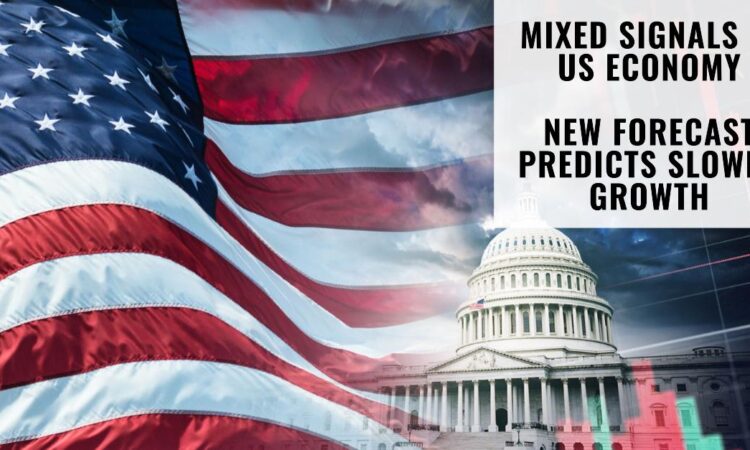
As we navigate through the second half of 2024, a recent report paints by Freddie Mac a complex picture of the U.S. economy. The Bureau of Economic Analysis (BEA) has revealed pivotal insights regarding economic growth, labor market conditions, and inflation. Here, we delve into these developments and offer a forecast for the economy ahead.
U.S. Economic Outlook & Forecast: Current Trends and Future Projections
Recent Developments in U.S. Economic Growth
The GDP growth rate for the first quarter of 2024 has been revised upward slightly by the BEA, now standing at 1.4% annualized, compared to an earlier estimate of 1.3%. Key factors influencing this revision include:
- Downward revisions to imports.
- Upward revisions to nonresidential investment and government spending.
However, the trend in consumer spending has raised concerns. The final estimate indicates a slowdown, with consumer spending growth dropping from 2.0% to 1.5% for Q1 2024. Consequently, consumption’s contribution to GDP also decreased from 1.3% to 0.9%.
| Measure | Q1 2024 Estimate |
|---|---|
| GDP Growth Rate | 1.4% |
| Consumer Spending Growth Rate | 1.5% |
| Contribution to GDP (Consumption) | 0.9% |
| Real Gross Domestic Income (GDI) | 1.3% |
The modest rise in GDP—though the slowest growth since Q2 2022—reflects a resilient economy. The increase in Real Gross Domestic Income (GDI), which also rose by 1.3%, indicates that economic activity remains robust at a fundamental level, highlighting the complexity underlying the current economic conditions.
Labor Market Adjustments: Mixed Signals
The labor market report from the Bureau of Labor Statistics (BLS) reveals a cooling trend that raises several important considerations about employment and economic health. Here are the key statistics:
- Total nonfarm payroll gains: 206,000 in June 2024.
- Revised downward payroll gains for April and May by 111,000 combined, which alters the previously optimistic view of job growth.
- Unemployment rate: has increased to 4.1%, which is significant as it reflects the highest level since November 2021.
The job openings in May were also noteworthy, with an increase to 8.1 million, indicating a still-active job market, albeit with caution. This comes even as the job openings to unemployed ratio fell to 1.22, the lowest since June 2021. Here’s a closer breakdown of the labor market trends:
- Dominant sectors: The bulk of the job gains in June occurred in sectors such as healthcare and social assistance, as well as government roles. This signals an ongoing demand for services, despite broader economic headwinds.
- Year-to-date job growth for 2024 now sits at 1.3 million, with an average of 222,000 jobs added each month. This reflects a decrease from the preceding month’s average of 247,000 jobs, highlighting a potential cooling in labor demand.
Inflation Trends: Signs of Moderation
On the inflation front, the core Personal Consumption Expenditure Price Index, the Federal Reserve’s preferred inflation metric, has provided some reassuring news:
- Month-to-month increase: 0.1% in May 2024.
- Year-over-year increase: 2.6%, marking the lowest annual rise since March 2021.
Key components of inflation to note include:
- Goods prices: decreased by 0.4% due to drops in energy and recreational goods. This is encouraging, suggesting that consumer demand for certain products may be stabilizing.
- Services prices: rose by 0.2%, with healthcare costs leading the increases. Despite the overall moderation in inflation, healthcare remains a significant driver of expenses for households.
Tracking inflation closely is paramount, as rising prices can prompt the Federal Reserve to adjust interest rates, further impacting consumer behavior and economic activity.
Economic Outlook: Forecast for 2024 and Beyond
Looking ahead, projections indicate that the U.S. economy will likely continue to grapple with the impacts of higher interest rates. Here’s what to expect:
- Slower growth rates anticipated for 2024 and 2025 as the labor market weakens. Analysts suggest a sustained trend of lower growth could prevail until inflation aligns more closely with the Fed’s targets.
- Inflation control measures: Incoming inflation data suggests that a potential rate cut may occur later this year, but only if the job market cools sufficiently to control inflation. Such a move, however, hinges on multiple factors, including external economic conditions and domestic spending habits.
- Mortgage rate implications: If the anticipated rate cut does take place, we could see a slight easing of mortgage rates in 2024. Should this occur, potential homebuyers might find an improved opportunities for homeownership, which has been gradually priced out of reach for many due to prior increases in borrowing costs.
Additional Considerations for Immigration Policies and Global Events
Beyond the domestic economic indicators, other factors deserve attention as they may significantly influence the U.S. economic forecast.
- Immigration policies: Shifting immigration patterns could impact labor supply, particularly in industries reliant on migrant labor. A tighter labor market could exacerbate challenges in sectors like agriculture and hospitality, where demand for workers remains high.
- Global economic conditions: Developments abroad, including potential geopolitical tensions, trade agreements, and international economic stability, will undoubtedly influence domestic economic trends. Changes in global supply chains and trade flows can affect import/export balances and subsequently impact GDP growth.
Conclusion: A Cautiously Optimistic Approach
In conclusion, while the current economic climate reflects certain challenges—especially in consumer spending and the labor market—the moderation in inflation gives some grounds for optimism. The U.S. economy demonstrates resilience, characterized by adjustments in various sectors.
As we progress through 2024, it will be essential for policymakers and consumers to remain attentive to these evolving dynamics. Understanding how growth, employment, inflation, and interest rates interact will be vital for navigating potential economic fluctuations in the near future.
ALSO READ:






